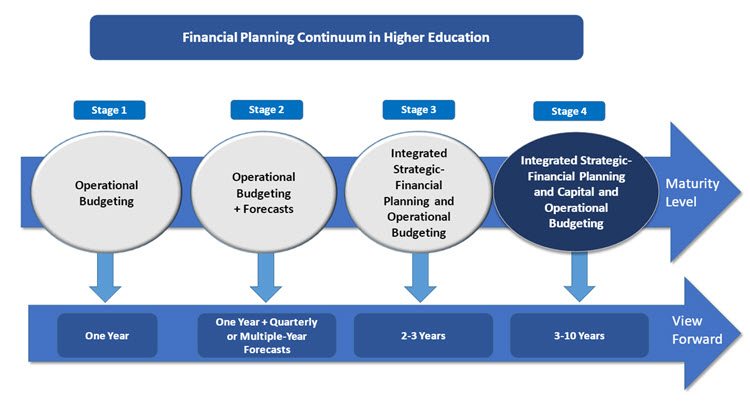
In making strategic decisions with financial and capital requirements, leaders must thoroughly take into account the various operational and strategic tradeoffs, long-term ramifications, and need for sustainability. Limiting support for decision making to an annual budget can be problematic in this regard.
Spending decisions with a one-year view forward may not align well to the institution’s multi-year strategic and financial plans.
In our whitepaper, Moving Forward on the Continuum of Financial Planning in Higher Education, we proposed a way for college and university leaders to advance their current planning process to accomplish the alignment objective. The graphic below shows the progression of planning improvement from Stage 1 planning focused on the operating budget with a one-year view, to Stage 4 integrated planning with a multi-year view forward. Stage 4 integrates resource decision making with multi-year strategic and financial planning, as well as capital and operating budgeting.

We believe that it is possible, and desirable, to move an organization in increments along the planning continuum toward a thoroughly integrated planning process. With such a process, all planning and budgeting activities at every level of the institution effectively link to the institution’s vision, mission, and academic priorities. A connected process ensures realization of the following benefits:
- Improved analytics and reporting to support better decision making
- Use of a uniform approach to evaluate all operating and capital decisions
- Faster and more strategic budgeting
- Improved visibility into the longer-term financial trajectory of the institution
- Protection of the institution’s capital capacity at a level that enables access to lower-cost debt options
An integrated approach helps leaders across silos to better understand each other’s realities and collaborate on plans for performance improvement and growth.
For example, with an integrated process, leaders can easily feed capital plans into long-term strategic plans, inform budget targets with expected student-faculty ratios and other projections, or update financial forecasts when strategies change.
A central tenet of this integrated planning process is the following: Financial performance must be sufficient to meet the cash-flow requirements of the strategic plan and, at the same time, maintain or improve the financial integrity of the institution within an appropriate credit and risk context.
Used since the early 1900s by blue-chip companies, and adapted for not-for-profit organizations and institutions in the mid-1980s, the integrated process involves:
- Identifying the strategies best able to achieve the institution’s mission
- Ensuring the funding of such strategies through debt, reserves, fundraising, or other sources
- Conducting solid risk assessment and scenario analysis related to the viability of each strategy and the overall portfolio of strategies to ensure effective deployment of resources
- Directly and aggressively supporting selected strategies with needed capital and resource allocation
For some institutions, the planning process involves a strategic plan that links to a financial plan; in others, the planning process results in one integrated plan. Either approach is appropriate if the key output is a fiscally sound business plan that provides the platform for both long-term and day-to-day decisions, enabling staff at all levels to respond to opportunities and challenges in a flexible, coordinated manner.
The 2019 Higher Education CFO Outlook: Performance Management Trends and Priorities report indicates that 82 percent of finance professionals believe that higher education lags other industries in adopting modern financial practices and tools. Do you? Given the industry’s financial challenges, leaders need to make investments to enhance decision making and commit to improvements in integrated planning within short time frames. Is a planning upgrade in process at your institution?









